

Civil War Curriculum Resources and Websites for Teaching the Civil War. Cropsouth.JPG (520×432) Plantation_land0001.JPG (1362×848) Solomon Northup. Twelve Years a Slave: Narrative ofSolomon Northup, a Citizen of New-York, Kidnapped in Washington City in1841, and Rescued in 1853. Twelve Years a Slave: Narrative of Solomon Northup, a Citizen of New-York, Kidnapped in Washington City in 1841, and Rescued in 1853: Electronic Edition.
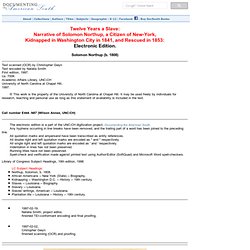
Solomon Northup (b. 1808) Text scanned (OCR) by Christopher Gwyn Text encoded by Natalia Smith First edition, 1997. ca. 700K Academic Affairs Library, UNC-CH University of North Carolina at Chapel Hill, 1997. © This work is the property of the University of North Carolina at Chapel Hill. It may be used freely by individuals for research, teaching and personal use as long as this statement of availability is included in the text. Call number E444 .N87 (Wilson Annex, UNC-CH) Teach American History. Select Teacher Resources items below: Civil War and Reconstruction (1850-1877) To view an essay, click on the title.
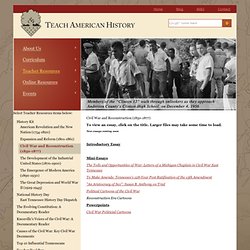
Larger files may take some time to load. New essays coming soon Introductory Essay Mini-Essays The Toils and Opportunities of War: Letters of a Michigan Chaplain in Civil War East Tennessee To Make Amends: Tennessee's 128-Year Post Ratification of the 15th Amendment "An Aristocracy of Sex": Susan B. Slave songs. Learning outcomes Students will: demonstrate an understanding of the role of religion in the lives of slaves.

Evaluate major themes surrounding the issue of religion and slavery. Teacher planning Time required for lesson 20-30 minutes Technology resources Computer lab or individual student computers Access to Documenting the American South resources Microsoft Word Pre-activities. Lesson Plan Titles. African American History Lesson Plans The African American Experience in NC after Reconstruction The documents included in this lesson come from "The North Carolina Experience" collection of Documenting the American South and specifically focus on African Americans and race relations in the early 20th century.

The lesson juxtaposes accounts that relate to both the positive improvements of black society and arguments against advancement. Combined these primary sources and the accompanying lesson plan could be used as a Document Based Question (DBQ) in an advanced US history or African American history course. Brown versus Board of Education: Rhetoric and realities In this lesson, students will listen to three oral histories that shed light on political and personal reactions toward the 1954 Supreme Court ruling Brown versus Board of Education. Though the ruling itself is not mentioned, words like "integration" and "forced busing" refer to the social outcomes as perceived by the speakers. IB History of the Americas - Mr. Slingerland's History Site. Gilder Lehrman Center. Slavery and Freedom in American History and Memory. Home | Events | Resources | Information | Gilder Lehrman Center Slavery and Freedom in American History and Memory Online Resources The Revolution Gone Backward Online Resources to supplement the April 27, 2007 workshop "The Revolution Gone Backward: The Memory of Reconstruction in African American Thought" From Moral Suasion to Political Confrontation.
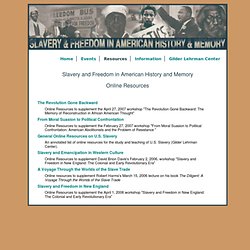
Gilder Lehrman Center. Plantation Life. Plantations had been used with great effect long before the Europeans settled in the Americas.

Sugar cane plantations, for example, had thrived around the Mediterranean in the late Middle Ages, supplying an expensive sweetener for Europe's élites. So when European merchants and adventurers began to sail and trade around the Atlantic, they took the plantation model with them and transplanted it into a string of new settlements – above all, in sugar. Slave Life on a Cotton Plantation, 1845. Slave Life on a Cotton Plantation, 1845 From Solomon Northup, Twelve Years a Slave, Auburn, NY: Derby and Miller, 1853, p. 163-171.
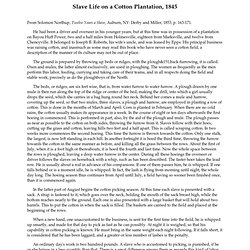
He had been a driver and overseer in his younger years, but at this time was in possession of a plantation on Bayou Huff Power, two and a half miles from Holmesville, eighteen from Marksville, and twelve from Cheneyville. It belonged to Joseph B. Roberts, his wife's uncle, and was leased by Epps. His principal business was raising cotton, and inasmuch as some may read this book who have never seen a cotton field, a description of the manner of its culture may not be out of place. The ground is prepared by throwing up beds or ridges, with the plough&151;back-furrowing, it is called. Life on a Southern Plantation, 1854. Life on a Southern Plantation, 1854 The moral inconsistency of slavery existing within a nation founded upon the sanctity of individual freedom was well recognized in the early days of America's history.
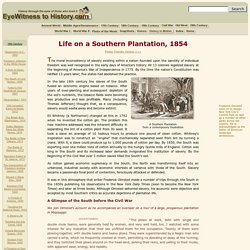
All 13 colonies legalized slavery at the beginning of America's War of Independence in 1775. By the time the nation's Constitution was ratified 13 years later; five states had abolished the practice. Slavery and the Making of America . The Slave Experience: Living. In the mid-nineteenth century, journals were published to enable more efficient plantation management.

These books included formatted calendars, lists, and charts, which planters or overseers could use to record information specific to their farms and estates. As journals and other documents show us, life on plantations could vary widely for slaves. Departments.mercer.edu/sst/Cotton Plantation Unit.pdf. The Southern Studies program at Mercer University examines the complex history and culture of the U.S.
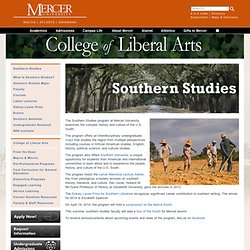
South.